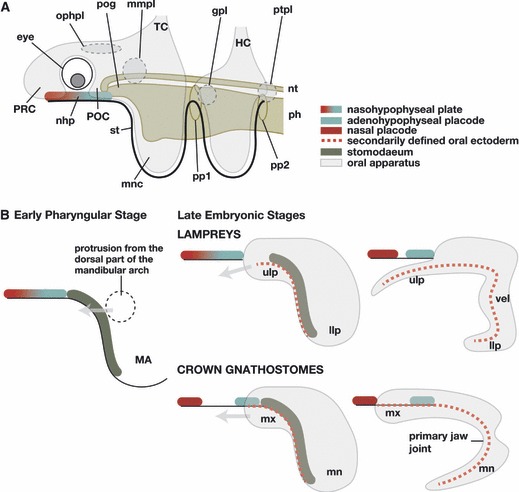Fig. 3.

Comparison of craniofacial development between the lamprey and crown gnathostomes. (A) The generalized morphological pattern of the vertebrate head common to the lamprey and modern gnathostomes. (B) The anatomical difference between the lamprey and modern gnathostomes becomes clear in the later developmental pattern. In both animals there is a dorsal part of the mandibular arch growing rostrally to form the dorsal roof of the oral apparatus. Note, in the lamprey, the upper lip contains the premandibular component, at least in its medial part. Because of the late separation of the nasohypophyseal plate, this rostral growth forms an oral roof beneath the nasal and hypophyseal placodes. In the gnathostomes, the dorsal part of the mandibular arch grows rostrally as the maxillary process, lateral to the hypophysis, to form a part of the upper jaw. The medially located premandibular structure (trabecula, not shown) also grows rostrally lateral to the hypophysis, separate from the maxillary process. gpl, Geniculate placode; HC, hyoid crest cells; llp, lower lip; MA, mandibular arch; mmpl, maxillomandibular placode; mn, mandibular process; mnc, mandibular arc crest cells; mx, maxillary process; nhp, nasohypophyseal plate or placodes; nt, notochord; ophpl, ophthalmic placode; ph, pharynx; pog, preoral gut; pp1–2, pharyngeal pouches; POC, postoptic crest cells; PRC, preoptic crest cells; ptpl, petrosal placode; st, stomodaeum; TC, trigeminal crest cells; ulp, upper lip; vel, velum.
